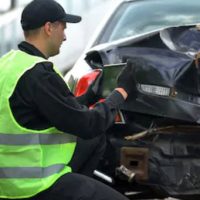How Location of Vehicle Damage in a Car Accident Can Help Determine Fault

In the aftermath of a crash, determining fault often ends up playing a critical role in the insurance claim process. When attempting to establish liability for a crash, investigators will look to the vehicle damage itself for a clearer picture of the cause of an accident. Read on to learn more about car accident vehicle damage and how it can help determine fault for a crash.
Determining the Events Leading Up to the Crash
The location of damage to a vehicle can tell investigators a lot about the circumstances that led up to a crash. If, for instance, two vehicles collided at an intersection, the impact on the side of one vehicle could indicate that the driver ran a red light or otherwise failed to yield properly. Damage to the front end of the vehicle, on the other hand, could suggest that one driver was speeding or failed to brake in time prior to the accident. By examining where such damage is located on the vehicles, investigators can start to piece together the series of events that led up to a crash.
Recreating the Accident Based on Angle and Force of Impact
The angle and force of impact (as revealed by the damage sustained by a vehicle during a crash) can also help experts recreate or simulate the accident in question. Furthermore, the severity of the vehicle damage, as well as its location, often correlates with the degree of negligence exhibited by the at-fault party. The faster a vehicle is going prior to the crash, for instance, the worse the damage will likely be. This is not always true, however, as where the impact force is concentrated will largely dictate how bad the damage is. For instance, in head-on collisions, the impact force is mostly concentrated at the front ends of the vehicles, which in turn leads to a more focused distribution of energy. A side impact crash, on the other hand, involves the spreading of force along the entire length of the vehicle, usually resulting in more extensive structural damage, but less serious injuries.
Utilizing Proof of Vehicle Damage to Support Your Case
Photographs of vehicle damage often end up being some of the most valuable evidence that an accident victim can use to recreate an accident and prove fault. This is why it’s so important for accident victims to keep careful records of their vehicle damage, including not only photographs, but also inspection reports from mechanics, and estimates for the cost of repair. This evidence can all be used by a claimant’s legal team to determine not only fault, but also the damages resulting from a crash.
Schedule a Free Legal Consultation with Our Legal Team
To speak with an experienced Florida car accident lawyer about the kinds of evidence you’ll need to improve the chances of success when filing your own car accident claim, please call us at Boone & Davis today. You can reach us at 954-566-9919 or by sending us an online message.
Sources:
forbes.com/advisor/car-insurance/determining-fault-after-accident/
michigan.gov/msp/divisions/spec-ops/inside-sod/traffic-crash-reconstruction-unit
